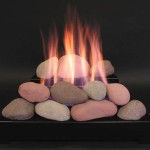How To Get Paint Off Victorian Fireplace Tiles
Victorian fireplaces, often adorned with intricate and colorful tiles, are a treasured feature in many older homes. These tiles can be a focal point, adding character and historical charm to a room. However, through the years, many of these beautiful tiles have been painted over, obscuring their original designs and diminishing their aesthetic appeal. Removing paint from Victorian fireplace tiles requires patience, careful planning, and the proper techniques to avoid damaging the delicate surface underneath. This article provides detailed instructions and considerations for safely and effectively restoring painted Victorian fireplace tiles to their former glory.
Before embarking on the paint removal process, it is crucial to identify the type of paint covering the tiles. Common paint types include latex, oil-based, and enamel. Knowing the paint type will dictate the appropriate removal method and the necessary tools and chemicals. Additionally, the type of tile itself should be considered. Victorian fireplaces often feature encaustic tiles (patterns inlaid into the clay), glazed tiles, or hand-painted tiles, each requiring slightly different handling.
Safety should always be a priority. Working with paint removal chemicals and tools can pose risks. Adequate ventilation is essential to avoid inhaling harmful fumes. Protective gear, including gloves, safety goggles, and a respirator mask, should be worn throughout the process. A drop cloth or protective sheeting should be placed around the fireplace to protect surrounding surfaces from stray paint and chemicals.
Testing a Small, Inconspicuous Area
Before applying any paint removal method to the entire fireplace, it is essential to test it on a small, inconspicuous area. This test will determine the effectiveness of the chosen method and identify any potential damage to the tile surface. Choose an area that is hidden or less visible, such as behind the firebox or near the floor. Apply the chosen paint remover to the test area and follow the manufacturer's instructions. After the recommended dwell time, carefully remove the paint and inspect the tile for any adverse reactions, such as discoloration, etching, or loss of detail. If the test area shows no damage and the paint is effectively removed, the method can be applied to the rest of the fireplace.
The test area provides valuable information about the paint’s adhesion to the tile. Heavily adhered paint may require multiple applications of the removal agent or the use of a more aggressive method. Conversely, loosely adhered paint may come off easily, requiring a gentler approach. Adjusting the dwell time and application technique based on the test area results can minimize the risk of damage.
Documenting the process with photographs before, during, and after the test area is helpful for tracking progress and identifying any issues. This visual record can serve as a reference point throughout the restoration process and aid in making informed decisions about the best course of action.
Gentle Paint Removal Methods
When dealing with delicate Victorian fireplace tiles, starting with the gentlest paint removal methods is always preferable. These methods minimize the risk of damage and are often effective for removing newer or poorly adhered paint layers.
One gentle method involves using a heat gun. A heat gun softens the paint, making it easier to scrape away. Hold the heat gun several inches away from the tile surface and move it slowly back and forth. Avoid overheating the paint, as this can cause it to bubble or burn, making it more difficult to remove. Once the paint is softened, use a plastic scraper to gently lift it away from the tile. Plastic scrapers are less likely to scratch the tile surface than metal scrapers. Work in small sections and be patient, as this method can be time-consuming.
Another gentle method is the use of steam. A wallpaper steamer or a handheld steamer can be used to loosen the paint. Direct the steam onto the painted surface for a few seconds at a time. The heat and moisture will soften the paint, allowing it to be scraped away with a plastic scraper. Similar to the heat gun method, work in small sections and be careful not to overheat the paint. The steam can also help to remove any residual adhesive or grime.
Citrus-based paint strippers are another gentler alternative to harsh chemical strippers. These strippers are biodegradable and less toxic than traditional options. Apply the citrus-based stripper to the painted surface according to the manufacturer's instructions. Allow the stripper to dwell for the recommended time, and then use a plastic scraper to remove the softened paint. Citrus-based strippers often have a pleasant odor and are less likely to damage the tile surface. They are particularly effective for removing latex paint.
Chemical Paint Strippers and Alternative Solutions
When gentle methods fail to remove stubborn paint, chemical paint strippers may be necessary. However, these strippers should be used with caution, as they can be harsh and potentially damaging to the tile surface. Always wear appropriate protective gear, including gloves, safety goggles, and a respirator mask, when working with chemical strippers. Ensure adequate ventilation in the work area.
There are various types of chemical paint strippers available, including liquid, gel, and paste forms. Gel strippers are often preferred for vertical surfaces, as they cling better and prevent dripping. Apply the stripper evenly to the painted surface, following the manufacturer's instructions. Allow the stripper to dwell for the recommended time, which may vary depending on the paint type and the stripper's formulation. After the dwell time, use a plastic scraper to remove the softened paint. A stiff brush can be used to help loosen paint in crevices or textured areas.
Once the paint has been removed, thoroughly clean the tile surface with a mild detergent and water to neutralize any remaining stripper residue. Rinse the tiles well and allow them to dry completely. Inspect the tiles for any damage or discoloration. If any damage is present, consider consulting a professional tile restorer.
An alternative to commercial chemical strippers is a homemade solution consisting of baking soda and washing soda mixed with water to form a paste. This paste is applied to the painted surface, covered with plastic wrap, and allowed to sit overnight. The next day, the paste and softened paint can be scraped away. This method is less aggressive than commercial strippers but may require multiple applications.
Addressing Grout and Cleaning Remaining Residue
After removing the paint from the tile surfaces, attention should be directed to the grout lines. Paint often accumulates in the grout, making it appear discolored and detracting from the overall appearance of the fireplace. Cleaning the grout lines can significantly enhance the restored look of the tiles.
A grout brush and a grout cleaner are essential tools for this task. Apply the grout cleaner to the grout lines, following the manufacturer's instructions. Allow the cleaner to dwell for the recommended time, and then scrub the grout lines with the grout brush. Rinse the grout lines thoroughly with water to remove the cleaner and any loosened paint. A small, pointed tool, such as a dental pick or a seam ripper, can be used to carefully remove stubborn paint from narrow grout lines.
Baking soda and vinegar can also be used as a natural grout cleaner. Mix baking soda and vinegar to form a paste, apply the paste to the grout lines, and let it sit for several minutes. Then, scrub the grout lines with a brush and rinse with water. For tougher stains, hydrogen peroxide can be applied to the grout lines and allowed to sit for several hours before scrubbing and rinsing.
After cleaning the grout, any remaining residue on the tile surfaces should be addressed. A mild detergent and water solution can be used to gently clean the tiles. Use a soft cloth or sponge to wipe the tiles, paying attention to any areas where paint residue may be present. Rinse the tiles thoroughly with water and dry them with a clean cloth.
Sealing and Protecting Restored Tiles
Once the paint has been removed, the grout cleaned, and the tiles thoroughly cleaned, it is important to seal and protect the restored surfaces. Sealing the tiles and grout will help to prevent future staining and damage, preserving their beauty for years to come.
A tile sealant is designed to penetrate the porous surface of the tiles, creating a protective barrier against moisture, dirt, and stains. Apply the tile sealant according to the manufacturer's instructions. Allow the sealant to dry completely before using the fireplace. A grout sealant is specifically designed to protect grout lines from staining and discoloration. Apply the grout sealant to the grout lines, following the manufacturer's instructions. Wipe away any excess sealant from the tile surfaces.
In addition to sealing the tiles and grout, regular cleaning and maintenance are essential for preserving their restored appearance. Wipe the tiles with a soft cloth or sponge after each use to remove any soot or ash. Avoid using harsh chemicals or abrasive cleaners, as these can damage the tile surface. Periodically inspect the tiles and grout for any signs of damage or discoloration. Address any issues promptly to prevent them from worsening.
By following these detailed instructions and considerations, homeowners can successfully remove paint from Victorian fireplace tiles, restoring their original beauty and adding value to their homes. Patience, careful planning, and the proper techniques are key to achieving a successful restoration.

Removing Paint From Victorian Fireplace Mumsnet

Restoring A Cast Iron Fireplace

How To Re A Cast Iron Fireplace

Period Fireplace Faq

Removing Old Paint From Victorian Hallway Tiles Cleaning And Maintenance Advice For Tiled Floors

Restoring Cleaning Crazed And Damaged Hearth Tiles Page 1 Homes Gardens Diy Pistonheads

How To Make Your Old Victorian Tiles Look Good As New Swoon Worthy

How To Re A Cast Iron Fireplace

How To Re A Cast Iron Fireplace Direct Fireplaces

How To Re A Cast Iron Fireplace And Surround Sharn S House








